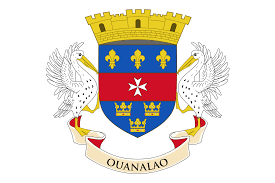Language/French/Culture/St-Barthelemy-Timeline
St. Barthélemy Timeline[edit | edit source]
St Barthélémy, connu sous le nom de St Barth est une île française des Petites Antilles. C’est de même, le meilleur endroit où gouter les spécialités culinaires des Antilles. C’est une petite perle au milieu des Caraïbes qui possède de nombreux restaurants raffinés et plusieurs sites incontournables. Saint Barthélémy est aussi une île qui raconte toute une histoire.
St Barthélémy, of the name Bartolomeo[edit | edit source]
Christopher Columbus was the first European to land on the island. This is why he named it Saint Bartholomew in honor of Bartolomeo, his brother. It was during his second voyage in 1493 that he gave the island this name. The island's Caribbean name was originally Ouanalao. In 1648, the island was occupied by the French for the first time. This, on the decision of Commander Lonvilliers de Poincy. The Hospitallers of the Order of St. John of Jerusalem ruled the island from 1651 to 1656. The island was abandoned until 1659. It was on this date that it became a French colony again. The island did not interest the French too much economically because with poor soil and a very dry climate it has no potential. In addition, it represents a strategic stake in the north of the Lesser Antilles thanks to its port which is naturally protected from the Carénage. At that time, the inhabitants of Saint Barthélémy lived by fishing, raising goats, harvesting salt, cultivating cotton and indigo.
Around 1787, the Carénage was renamed Gustavia[edit | edit source]
In 1784, Louis XVI cedes Saint Barthélémy to King Gustav III of Sweden. This session was carried out against a warehouse fee in Gothenburg. The island therefore became a free port in 1785. Around 1787, Carénage, the main town of the island, was renamed Gustavia, which is the capital of Saint Barthélémy today. Slavery was finally abolished there in 1847, especially on October 9. In 1852, the island was not spared by the passage of a cyclone. Its capital was also the victim of a fire in 1852. And since nothing was left of it and the island had no more economic resources, the King of Sweden and Norway Oscar II ended up ceding it to France. In 1877, the retrocession treaty was approved by a consultation with the inhabitants of the island. This is how Saint-Barthélémy became attached to Guadeloupe on March 16, 1878 after France had paid a sum to the King of Sweden. The latter donated the sum received to the island.
1946, a plane arrives for the first time on the island[edit | edit source]
French adventurer Rémy de Haenen first landed on the island with a plane in 1946. He landed in savannah terrain. Later, on this land, Saint-Barthélemy-Rémy-de-Haenen airport was built. In 1953, this French adventurer bought a piece of land for a few hundred dollars. The potential of Saint Barth was part of this land which is located in the bay of Saint-Jean. In 1957, a modernist villa was built at Colombier Cove by David Rockefeller. Many people imitate the billionaire and in turn build villas. Then came the 1960s, and the island became a luxury tourist destination. In addition, a law prohibits the construction of high-rise buildings. This period was also marked by the absence of mass tourism.
1962 to 2007: the island expands, municipalities are set up[edit | edit source]
A sub-prefect who resides in Saint-Martin administers the municipalities of Saint-Martin and Saint-Barthélémy. These municipalities constitute the 3rd arrondissement of Guadeloupe, they are also the northern islands. In 2003, that is to say on December 7, the inhabitants of Saint-Barthélémy, in particular the voters, approved an institutional project which makes of Saint-Barthélémy, a territorial collectivity with single assembly and which is detached from the DOM-ROM of Guadeloupe. This approval was supported by popular consultation, with a participation of 78.71% and 95.51% of the votes cast. In July 2007, there was a convocation of the first territorial elections of the beautiful island. The latter was then officially an overseas territorial collectivity on July 15, 2007.
Sources[edit | edit source]
- http://www.voyager-st-barths.com/st-barthelemy-histoire-et-chronologie-complete
- https://fr.wikipedia.org/
- https://www.petitfute.com/
- https://www.kronobase.org/
World Timelines[edit source]
Other Lessons[edit | edit source]
- French territories
- Funny idiomatic expressions
- Diego Garcia Timeline
- Vaincre ou Mourir
- The Castlebar Races
- French Major Historical Dates
- Clipperton Island Timeline
- Gabon Timeline
- St Martin Timeline
- Cameroon Timeline


